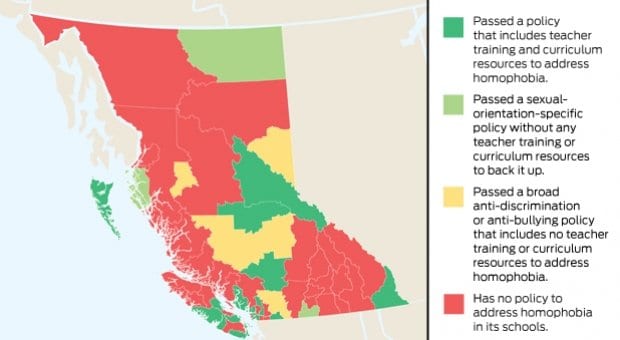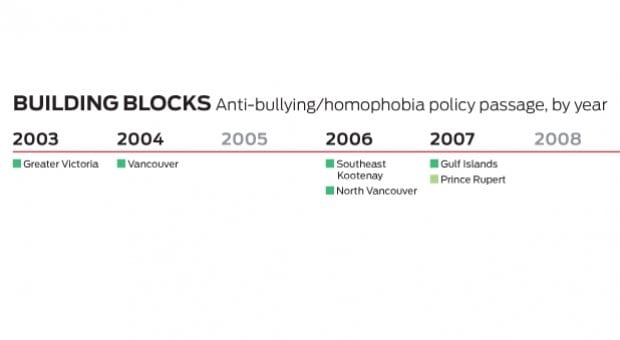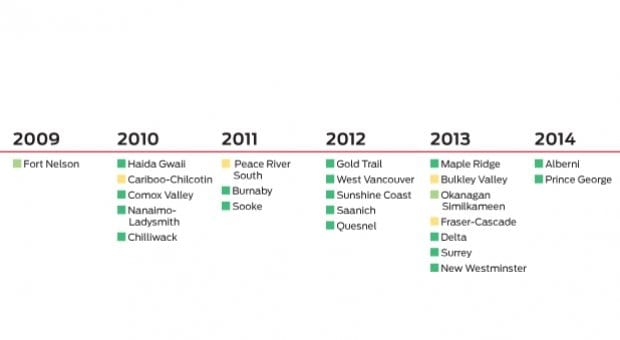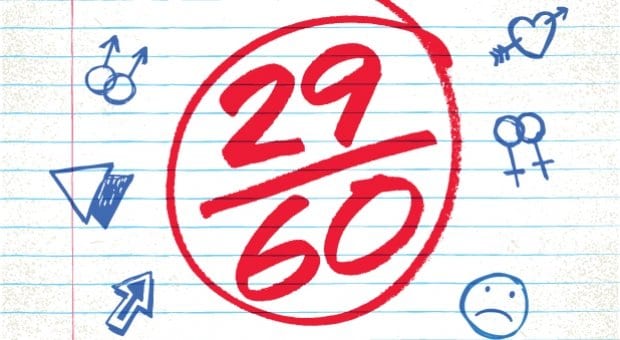
Progress report: anti-homophobia and bullying policies across BC. Why is most of the province red? Credit: Bryce Stuart

Building blocks: anti-bullying/homophobia policies passed, by year Credit: Xtra staff

Building blocks continued: anti-bullying/homophobia policies passed, by year Credit: Xtra staff
Kika Mueller was in Grade 1 when Victoria’s school board made history in 2003 as the first in BC to adopt a policy to address homophobia and support its gay students and staff.
The policy may have looked good on paper, and been introduced with good intentions, but Mueller didn’t know it existed until she started high school eight years later.
“When I was in middle school, we didn’t have a GSA [gay-straight alliance], and I got homophobic comments from classmates and people I didn’t even know,” she recalls. “The teachers wouldn’t do anything if they overheard.”
Life improved when she began classes at Esquimalt High, where 30 to 40 students belong to a GSA that now offers anti-homophobia workshops to some of the district’s middle schools. The group is prominently advertised, Mueller says, and teachers post anti-homophobia posters on their walls, hold students accountable for their homophobic remarks, and include queer content in the curriculum.
There’s even a teacher-librarian who stocks a “rainbow reading section” and creates queer-themed displays throughout the year, she says.
Of BC’s 60 school boards, 29 have, like Victoria, passed some sort of policy to address homophobia in the last decade. But how effective are these policies, and what separates a good policy from words going nowhere on paper?
Victoria’s associate superintendent, Dave Pitre, says each policy is only as effective as the local administrators and teachers who decide to implement it.
“Truthfully, it will be a ragged front dependent upon the leadership of adults in individual schools,” he says. “The effort is to try to continuously stress the intent and purpose of what this policy is about. And I’ll be the first to admit we have things we need to do. One of them would be to ensure complete involvement across the district.”
“For me it goes this way: if you’re going to have a group in the school that is working towards something like this,” he says, “it really does need some adult support.”
Districts can encourage but not order teachers to implement the policy in full, he notes.
***
James Chamberlain sued the Surrey school board to add gay-friendly books to its classrooms in 1997. For a policy to be effective, he says, it should include provisions to add gay content to the curriculum; professional development for school counsellors, teachers and administrators; and a district-wide committee that will monitor the policy’s implementation and seek community feedback.
“A good policy sends a strong message to the school community and district as to what is acceptable and unacceptable,” he says.
Curriculum additions are essential to changing school cultures, he says, to foster environments that welcome and value gay people. “Because if you just pass a policy and it sits there in a board office or binder and you don’t breathe life into it and make it real for students, it’s a policy on the books but does not have systemic impact.”
When asked about the weakest approaches in the province, Chamberlain points to North Vancouver’s homophobia policy, which he describes as “very poor.”
North Vancouver was court-ordered to address homophobia proactively in 2005, following a nine-year legal battle with a former student who filed a complaint with the BC Human Rights Tribunal after years of unsuccessfully protesting homophobic harassment from classmates who regularly punched, spat at him and called him a “faggot” while district officials did little to intervene.
Victoria Miles, the district’s communications manager, says the policy, with the school codes of conduct, “assists in addressing incidents where disrespect or discrimination might have occurred.”
She says a “great deal of progress” has been made since the policy’s implementation and points to several gay guest speakers who have addressed students in the last eight years.
However, students and at least one GSA teacher-sponsor in the district were not even aware the policy existed, Xtra discovered last January.
“Your policy is only as good as the work that comes afterwards,” says Comox Valley superintendent Sherry Elwood, who describes her district’s policy as a “living and breathing event.”
Elwood says a committee meets throughout the year to ensure that teachers, administrators and support staff receive updated resource materials and training opportunities. One of her favourite teaching tools is a play written and performed by Courtenay students about the homophobia they hear in the hallways, woven together with stories from the late Jamie Hubley, a gay Ottawa teen who killed himself in 2011.
She says curriculum has been developed around the play, which has been used in staff and teacher training, including an especially poignant production attended by all the district employees, as well as Hubley’s parents, Allan Hubley and Wendy Barber. “When I introduced them to the audience of employees, I had men and women who may have been groundskeepers or mechanics later come up to me and say, ‘Oh my god, Sherry. I hadn’t thought about this really.’ That was a teachable moment.”
***
Having studied all the anti-homophobia policies in the province, the vice-president of the BC Teachers’ Federation (BCTF) points to Vancouver’s as the strongest.
“Ten years ago, the VSB [Vancouver School Board] adopted a policy that hit all the right notes,” Glen Hansman says. “It wasn’t just about students, but the whole school community. There was a commitment to resources, supporting peoples’ choices to come out, and an action plan attached to it that was implemented immediately.”
“Money was budgeted to support the implementation — and there still is,” he continues. “They train people — key people — to buy and purchase resources for school libraries. They make sure teachers in schools have at their disposal lesson-plan ideas and created a position at district level so there is a go-to person.”
The policy mandates that gay content be included in the curriculum and that staff receive ongoing anti-homophobia education. All elementary and secondary school libraries include LGBT books, students receive LGBT-specific sexual education, there are LGBT safe contacts in every school, and there is a GSA in every high school.
But a strong and well-implemented policy is not the exclusive domain of large urban centres.
Chamberlain notes that in smaller towns a small group of people with a high degree of credibility can be the impetus for significant change. He points to the Quesnel school district, where Dennis Hawkins-Bogle and his husband, Stephen Hawkins-Bogle, serve as principals.
“We’re not in the closet, so we’re able to talk about our lives in front of students, staff or parents,” Dennis Hawkins-Bogle explains. “I think that having people like myself or Stephen is really critical because people are really eager to talk and want to know things and are not sure how to ask because they are worried they might offend you. So when you are out of the closet, it eases that apprehension a little more.”
He remembers an instance when a teacher wasn’t sure how to approach the topic of same-sex families in a kindergarten class. “That’s a case of apprehension and the unknown, so when the person was given language skills and confidence to approach that the first time, they will be able to do it every time after that,” he says.
“These aren’t people who are against what’s happening in any way. They are just unsure how to proceed.”
Since Quesnel’s Sexual Orientation and Gender Identity policy was implemented in 2012, Hawkins-Bogle says, teachers have been more comfortable using inclusive language, and district principals report a decrease in what he describes as the “that’s so gay” culture.
***
Unlike Quesnel, Maple Ridge-Pitt Meadows decided against a stand-alone policy that specifically names and focuses on homophobia, choosing instead to merge it with a broader conduct policy.
The merged policy nonetheless includes district and school codes of conduct; a section on safety and security within schools; a glossary of terms, half of which are specific to sexual orientation or gender identity; and implementation guidelines specific to sexual orientation and gender identity.
Last fall, the district also formed an LGBT implementation committee to build an action plan to ensure the policy is implemented and applied consistently throughout the area’s schools.
Presentations about the policy have since been made to schools, administrators and parent advisory councils. The committee has also developed a presentation for administrators to share with their staff on an annual basis.
“The focus of this presentation is multifaceted: it introduces our district policy, shares the many unique challenges our LGBTQ community faces, and outlines our district expectations and future implementation action plan,” says Sherri Skerratt, the district’s counsellor of safe and caring schools.
The committee plans to incorporate professional development at every district-based professional development day and to examine the K-12 curriculum to make it more inclusive of LGBT topics. “We are looking to districts that are ahead of us in this process who have very strong, thriving school communities in which our students and employees who identify as LGBTIQQ feel the safety, care and belonging necessary to thrive in our community,” Skerratt says.
Hawkins-Bogle lauds the efforts of Maple Ridge and notes that a good implementation strategy is the key to an effective policy.
He does, however, express concern about the policy’s ambiguous title.
“Right off the bat, the name of the policy is critical,” he says. ‘If your policy is called ‘safe and caring schools’ or ‘school behaviour code’ or something along these lines, it certainly is not going to have the presence as one called ‘sexual orientation and gender identity.’ I think that’s more effective, as it allows people who are perusing the policy manual to see that there’s really strong value in words on a page, and when the title is ‘sexual orientation and gender identity,’ to me that speaks volumes. It shows a stronger commitment.”
But it’s no guarantee of a strong policy. Fort Nelson adopted a stand-alone Sexual Orientation (LGBTQ) policy in 2009 that focuses primarily on enhancing broad anti-bullying initiatives.
“The schools really treat it as part of the anti-bullying and anti-discrimination process,” says superintendent Diana Samchuck, who describes the policy as “present and alive” in the district. “Students are encouraged to come forward if they are bullied or harassed, and incidents are always investigated. We put steps in place that students feel safe.”
She says the small population of her district makes it more efficient to incorporate discussions about anti-homophobia into overarching bullying discussions. But she has yet to meet a single openly gay or trans student in her more than 30 years working in the district.
“With that being said, there aren’t many students who really state their sexuality until after they leave town,” she says. “I’m sure that’s for a wide range of reasons. Perhaps it is partly because this is a resource-based community. The oil and gas industry are kind of macho, and so they could be afraid of not being accepted.”
Haida Gwaii superintendent Angus Wilson describes his district, which adopted its Sexual Orientation policy in 2010, as a fairly progressive community that is generally supportive of LGBT people.
“Kids who have come out that I know are welcome and supported by their friends, and some of the parents have been really terrific,” he says. “Overall, the communities are more welcoming to lesbians than gay men, though.”
He says the challenges in his district — which employs openly gay and lesbian teachers and counsellors — have more to do with size than social pressures. He says coming out can be complicated by the general lack of anonymity in small communities. He says also that his district, which has fewer students than a typical Vancouver high school, does not have the numbers to support dedicated LGBT groups.
“When you talk about GSAs, that’s not a district club or association; that would be just a part of the student council — and even having a student council can be a challenge because George Dawson Secondary has 98 kids and Queen Charlotte Secondary has only 142.”
Hansman maintains that all LGBT students and district employees should feel comfortable coming out, regardless of where they live in the province.
“That shouldn’t be dependent on how close they are to an urban centre, where they were born or where they have a job,” he says. “The province needs to take the lead so there aren’t any gaps. If an individual school district wants to supplement the provincial standards by having something superior, then great. But there has to be a baseline that says, ‘This is important, we recognize this and we are all doing it.’”
Hansman says the excuse used by some districts, that the materials are not available or there are not enough tools to provide LGBT education, is not applicable in British Columbia. “The resources and people are there, and all that is required now is the will to do it,” he says. “The BCTF has trained facilitators who provide three or four workshops on homophobia in particular, and we make them available free of charge to any district in the province. As long as we get a group of at least 15 people, we will put it on. Teachers pay their union dues and this is what it goes towards.”
***
Without leadership from the provincial government, Chamberlain says the fight will continue to be a piecemeal approach of “hashing it out district by district.”
But, he says, it’s only a matter of time before all school boards adopt policies.
“I think we will get better results community by community,” he notes. “If you look at those people in Haida Gwaii, Fort Nelson, Cranbrook, Quesnel or Comox having these conversations — good, bad or otherwise — it’s important. And each local community is going to come up with something that’s going to be positive out of this, I believe. There’s no way they couldn’t come up with something positive in this day and age. If we left it up to the provincial government, we’d get some watered-down diluted thing that’s not substantial enough.”
In 2012, Premier Christy Clark launched a $2 million Erase Bullying program, which is described in a government fact sheet as a 10-point “comprehensive prevention and intervention strategy designed to address bullying and harmful behaviours in schools.” In its overarching approach, it does nothing to address homophobia specifically, beyond prohibiting discrimination on the basis of sexual orientation.
Education Minister Peter Fassbender explains that his government does not want to single out “any one group,” opting instead for an integrated approach that covers all protected classes in the BC Human Rights Code.
“It protects every student regardless of lifestyle choice, ethnic background and all those things,” Fassbender tells Xtra. “We operate under the BC Human Rights Code, and we encourage school districts and support those districts that have enhanced those codes of conduct.
“From my perspective, and the government’s perspective, we are supporting and making sure there is not bullying and discrimination in schools. Through the Erase Bullying strategy, we have safe-schools coordinators in every district in the province,” he says.
Hawkins-Bogle worries that umbrella policies do not highlight the importance of LGBT issues.
“I can’t speculate what it will look like down the road in 10 years,” he says. “I think the more that educators, principals, vice-principals and superintendents lead on this, the more potential there is for systemic change. It’s about educational leaders leading by example.
“We’re not just simply doing something different; we’re actually correcting an error, and there’s a difference between the two things,” he continues. “When you are correcting something done historically wrong, you need some justification — people want to see why this is important to us. There’s some data, here’s some history, this is what kids are experiencing today, and this is why we have to do things.”
Chamberlain says it should no longer be a scary thing for boards to adopt anti-homophobia policy.
“School trustees in every district should lead on this now because it falls on the right side of human rights,” he says. “It falls on the right side of equality and safety for every student, and it falls on the right side of the law in 2014.”
Related reading
Editorial: A Patchwork of Progress.

 Why you can trust Xtra
Why you can trust Xtra


